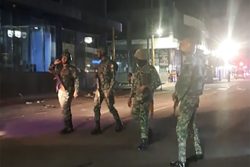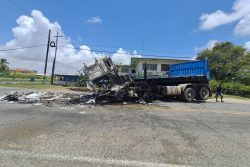While it is still not clear if the new container scanner installed by the Guyana Revenue Authority (GRA) is up and running, the agency has published notices informing exporters and shipping agents of the need for containers to be scanned before they depart for the US and the requirements for such.
Sources had told this newspaper that up to last Sunday the scanner was still not up and running and that the agency was awaiting the US-based person who installed it to return to fix the problem.
According to one of the notices, the GRA informed exporters that containers leaving Guyana will be subject to inspection using the newly installed scanning terminal and all inspections will be done at the Guyana National Shipping Corporation (GNSC) wharf.
“The scanner will reduce the time taken to do an inspection since the process is non-intrusive and will ultimately increase efficiency. The scanner will also safeguard against revenue loss,” the notice said.
The agency said that the new arrangement is a part of the GRA’s continued effort to modernise its customs operations and is also one of the trade requirements between Guyana and the US.
One of the notices directed to exporters informed that all containers destined for US ports will be scanned electronically at the scanning facility located at the GNSC wharf. It explained that containers destined for other ports would be scanned based on risk profiling and intelligence gathered. Exporters are also required to notify the GRA of their intent to ship at least five working days in advance by completing an application giving the time and place for stuffing of containers.
Following the uplifting of application forms exporters must complete and submit an Export Declaration Form (C72) with relevant licences, permits and certificates attached for verification and processing and payment of applicable fees. When the documents are uplifted exporters are asked to check with the Law Enforcement & Investigation Division (LEID) for directions on stuffing/examining and scanning the container. It was stated that authorised personnel of all relevant departments/agencies (granting various permits) when required must be present for the stuffing of the container(s) and will be required to sign all requisite documents.
Another of the notices said with the implementation of the scanner all shipping agents should notify potential exporters that it is mandatory for them to inform the GRA of their intent to ship consignments at least five working days in advance of their intended date for shipping with the completion of an application form to be obtained from Customs & Trade Administration and the Customs Boathouse. It said that the notice must take into consideration the times and place for stuffing of containers.
Exporters must confirm the booking made with the shipping agents and provide the name and address of consignee; name of shipping vessel; expected date of departure; description of goods; time/place/location of container if it was done in private; time/transit shed for stuffing container; confirmation of containers issued by shipping agent; confirmation of booking with shipping agency; and taxpayer identification number (TIN).
After receiving notification from the GRA of the date and time for scanning of the container, the shipping agent must be available to take the container to the scanning terminal located at the GNSC wharf.
Containers must be at the facility at least ten minutes prior to the scheduled time of the allotted date. Scanned containers should then be taken to the port of exit and placed in a secured/santised area prior to shipping.
The GRA warned that failure to comply will result in rescheduling.
Meanwhile, in a notice to hauler operators, the GRA advised all drivers that upon receiving notification from the Manager of the Scanner Operations Section, in respect of the date and time for containers to be scanned, drivers are to be at the scanner terminal ten minutes prior to the scheduled time of inspection and report to the scanner operator. They are required to move vehicles under inspection to thirty feet from the entrance of the container scanner and the freightliners must be driven through the scanner portal at a speed of 3.5 mph or 5 kph without stopping. Drivers must stop at the designated stop mark or when directed and must reverse within the controlled area/zone. Drivers who fail to comply will be required to repeat the process when a new appointment is scheduled.
The fact that the container scanner was not working months after it was installed last year was brought to light following the bust of a large quantity of cocaine in Jamaica last month.
It was only after this that Commissioner-General of the GRA Khurshid Sattaur had related that the scanner was not working. It is believed that if the scanner was working the cocaine might have been detected.
Persons are yet to be charged in that bust weeks after the Customs Anti-Narcotic Unit (CANU) completed its investigations. A source said that the file has been sent to the Director of Public Prosecutions (DPP) and it has since been instructed that some additional information be requested from the Jamaican authorities.
This request has been made and the CANU investigators are awaiting a response while the three persons who were initially held following the bust remain on bail.









